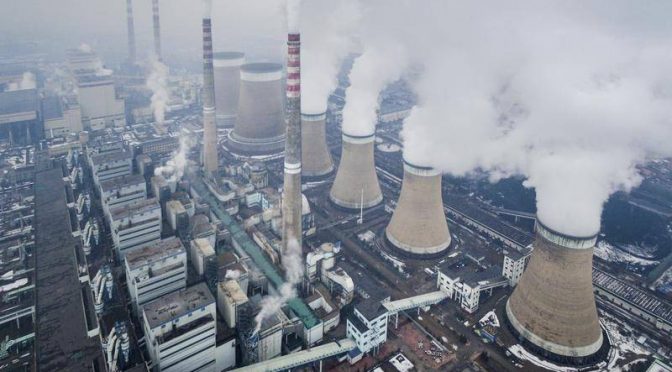
China’s growing coal-fired power generation capacity
China’s power companies are reported to have resumed the construction of large numbers of coal-fired power plants, despite a massive excess of generating capacity. Investment in non-fossil fuel capacity also proceeds. The government continues to deploy low-carbon policies and is introducing competition to the power sector. The outcome for the fuel mix is uncertain.
The role of coal
Coal forms the core of China’s energy supply, accounting for 58% of primary energy supply and 67% of electricity generation in 2018. Consumption of coal peaked in 2013, then fell marginally before rising again in 2018. It is reported to have risen nearly 4% in 2019. Production of coal is also rising, as are imports. Carbon dioxide emissions from energy have followed a similar trend. Because China accounts for 50% of global demand, these trends have significant consequences for climate change.
Recent reports show that the construction of coal-fired power plants continues, despite existing plants operating at below 50% capacity for the fourth year running.
An additional 25 gigawatts came online in 2018, bringing to total capacity of coal-fired plants in China to 1,000 GW. 17 gigawatts more were commissioned in the first half of 2019. The key recent development is the report that 121 gigawatts of plants are under active construction. Most of these were part of a surge of construction between 2014 and 2016 that was then suspended. A further 26 gigawatts are still suspended but might resume. The reason for the suspension was that the central government deemed the new plants unnecessary and a waste of resources. Although older plants are being decommissioned, this is progressing at an annual rate of only about 15 gigawatts, significantly less than the rate at which new plants are coming online.
Due to overcapacity in power generation, more than half of the coal-fired units of the ‘big five’ state-owned power generating companies are operating at a financial loss.
As a first step to addressing this, the government announced in early December 2019 that it would force the consolidation of these companies’ generating assets across five provinces in northwest China, leaving each company as the dominant actor in one province. At the same time, more power plants across this region would be decommissioned.
Despite their financial losses, power industry bodies support the continued construction of coal-fired power plants. They variously project that China will need 1,200-1,300 gigawatts of coal-fired capacity by 2030, and as much as 1,400 gigawatts by 2035 — a significant increase on the 1,000 gigawatts reached at the end of 2018.
Key arguments in favour of coal-fired plants are: the abundance and cheapness of domestic coal; the potential to use these plants flexibly to balance variable renewable energy; and the ‘cleanness’ of the new ultra-supercritical plants installed with scrubbers to reduce air pollution.
The first of these points may enhance security of supply, but the other two are less valid. Deploying coal-fired plans to balance renewables is not as efficient as using gas-fired plants or pump-storage hydropower. Without carbon capture, even the most modern coal-fired plants emit significant quantities of carbon dioxide. Nevertheless, these plants are still allowed to issue green bonds to finance improvements in energy efficiency and air pollution.
A more likely reason for expanding coal-fired generation capacity is that state-owned power companies with soft budgetary constraints are colluding with local governments to sustain investment, employment and local economic growth, while more pressing challenges occupy the central government’s attention.
Renewables and nuclear
Wind, solar and nuclear power capacity are also growing, even though subsidies are being gradually reduced. Solar photovoltaic installation in 2019 is likely to have been significantly less than the 44 gigawatts installed in 2018, but the total installed capacity may still reach close to 210 gigawatts. The government aims for 250 gigawatts of installed capacity of wind energy by 2020, up from 185 gigawatts at the end of 2018.
New nuclear power plants are being commissioned every year, though not as fast as the government projected. Nevertheless, 53 gigawatts will be operational by the end of 2020, up from 42 gigawatts at the end of 2018. China had more than 350 gigawatts of hydropower plants at the end of 2018, of which about 30 gigawatts was pumped storage. Curtailment (the non-dispatch of available energy) is a problem for all forms of renewable energy, though it is less severe than three or four years ago. Even some nuclear plants have been operating well below capacity.
Excess capacity
The continued construction of additional power generating plants of all types will exacerbate the surplus. Power consumption has reportedly risen only about 4.5% in 2019, down from 7.7% in 2018. Even with the government’s modest economic stimulus, excess capacity is likely to persist for at least several years.
A number of new policy programmes are being rolled out: provinces are being allocated renewable energy quotas; power markets are starting to operate at provincial level, involving bilateral trading and spot markets; and a national carbon emissions scheme is being designed drawing on the experience of local pilots markets that have been running since 2013. This was meant to go live in 2020, but has been delayed due to responsibility for the scheme being transferred from the National Development and Reform Commission to the new Ministry of Ecology and Environment.
So….
The key question is how this mix of policies and interests will shape the fuel mix for electricity generation over the next few years. Will low carbon sources be favoured at the expense of coal? In which case, actors along the full coal supply chain will be bankrupt. Or will coal receive favourable treatment, either through central government policy or local government protectionism? The likely outcome, as is often the case in China, is a messy compromise in which the share of coal in electricity generation declines slower than might be hoped, allowing the share of non-fossil fuels to rise, but at a rate well below its potential.

